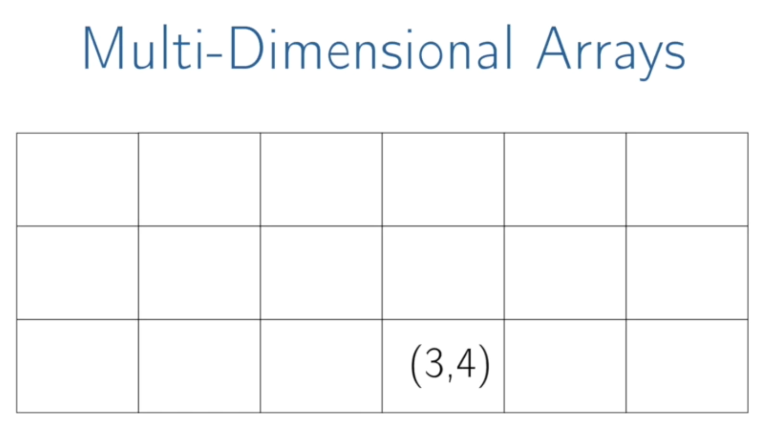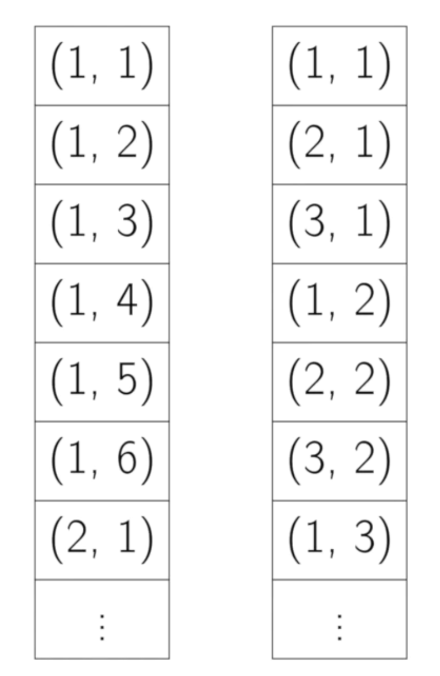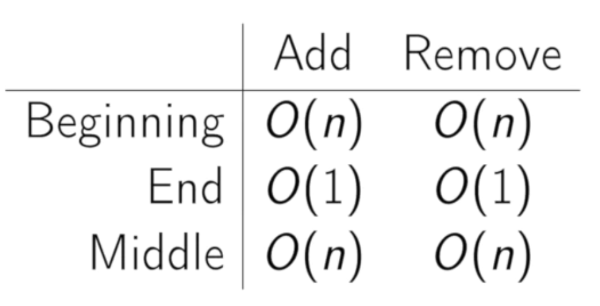🐣 2. Data Structures
📚 1. 배열과 문자열
1. Hash Tables
- 해시테이블 : 효율적인 탐색을 위한 자료구조
키(key)를 값(value)에 대응한다.
간단한 해시테이블 구현 방법
- 연결리스트(linked list), 해시 코드 함수(hash code function)
- 해시테이블 데이터 삽입 과정
- 키의 해시 코드를 계산한다.
- 키의 자료형은 보통
int혹은long이 된다. - ➡️ 이는 서로 다른 두 개의 키가 같은 해시 코드를 가리킬 수 있음을 나타냄!
- 키의 자료형은 보통
hash(key) % array_length와 같은 방식으로 해시 코드를 이용해, 배열의 인덱스를 구한다.- 배열의 각 인덱스에는 키-값 으로 이루어진 연결리스트가 존재한다.
- 충돌에 대비하여 반드시 연결리스트를 이용한다!
- 키의 해시 코드를 계산한다.
🤔 해시 충돌?
- 서로 다른 두 개의 키가 같은 해시 코드를 가리키거나
- 서로 다른 두 개의 해시 코드가 같은 인덱스를 가리키는 경우
🕐 수행 시간
- 최악의 경우 : $O(N)$
- But 일반적으로 해시에 대해 이야기할 때는 충돌을 최소화하도록 잘 구현된 경우를 가정한다. ➡️ 이 경우는 O(1)
2. ArrayList & Resizable Arraya
ArrayList : 동적 가변 크기 기능 내재 자료형
- ArrayList는 필요에 따라 크기를 변화시킬 수 있으면서 $O(1)$ 의 접근 시간을 유지한다.
- 배열이 가득 차는 순간, 배열의 크기를 2배로 늘린다.
크기를 2배 늘리는 연산은 $O(N)$ 이지만 자주 발생하지 않으므로, $O(1)$이 된다.
- _ ⭐️상환 입력 시간 개념 도입!_
3. StringBuilder
- 문자열을 하나로 이어붙이는 방법
- ex1
1
2
3
4
5
6
7
String joinWords(String[] words){
String sentence = "";
for (String w : words) {
sentence = sentence + w;
}
return sentence;
}
- 문자열을 이어붙일 때마다 새로운 문자열에 복사하는 방법
- 처음에는 x개, 두 번째는 2x개, 세 번째는 3x개, n번째는 nx개의 문자를 복사한다.
시간복잡도 : $O(xn^2)$
- $1 + 2 + … + n = n(n + 1)/2$
- ex2
1
2
3
4
5
6
7
String joinWords(String[] words) {
StringBuilder sentence = new StringBuilder();
for (String w : words) {
sentence.append(w);
}
return sentence.toString;
}
StringBuilder를 이용하여 가변 크기 배열을 사용하는 방법- 필요한 경우에만 문자열을 복사하게끔 한다.
📚 2. 연결리스트
- 연결리스트 : 차례로 연결된 노드를 표현해주는 자료구조
- 단방향 연결리스트 : 개별 노드 ➡️ 다음 노드
- 양방향 연결리스트 : 개별 노드 ➡️ 다음 노드 & 이전 노드
- ⭐️ 시작 지점에서의 아이템 추가 및 삭제 연산이 상수 시간 소요
1. Creating a Linked List
- 단방향 연결리스트 구현 코드
1
2
3
4
5
6
7
8
9
10
11
12
13
14
15
class Node {
Node next = null;
int data;
public Node(int d) {
data = d;
}
void appendToTail(int d){
Node end = new Node(d);
Node n = this;
while(n.next != null){
n = n.next;
}
n.next = end;
}
}
- 단방향 연결리스트에서의 고려사항 :
head가 바뀌면 어떻게 되는가?- 👉
head가 바뀌었음에도 어떤 객체는head를 계속 가리키고 있을 수도 있다. Node클래스를 포함하는LinkedList클래스를 만든다.(head Node변수에 head를 가리키는 값 저장)
- 👉
2. Deleting a Node from a Singly Linked List
- 삭제 노드 : n
prev.next를n.next로 연결한다.- (양방향 연결리스트일 경우)
n.next.prev를n.prev로 연결한다.
- ⚠️ 메모리 관리가 필요한 언어를 사용해 구현하는 경우에는 삭제한 노드에 할당되었던 메모리가 제대로 반환되었는지 확인 필요!
- 노드 삭제 코드
1
2
3
4
5
6
7
8
9
10
11
12
13
14
15
Node deleteNode(Node head, int d) {
Node n = head;
if (n.data == d) {
return head.next;
}
while (n.next != null) {
if (n.next.data == d) {
n.next = n.next.next;
return head;
}
n = n.next;
}
return head;
}
3. The “Runner” Technique
- Runner : 연결리스트를 순회할 때 두 개의 포인터를 동시에 사용한다.
- 한 포인터가 다른 포인터보다 앞서도록 하고 포인터를 움직일 때 지정된 개수 혹은 여러 노드를 한번에 움직일 수 있도록 설정한다.
4. Recursive Problems
- 연결리스트 문제 ≒ 재귀 호출
- ⚠️ 재귀(recursive) 알고리즘은 적어도 $O(n)$의 공간 복잡도를 갖는다!
🎓 1. CS50 2020 - Lecture 2 - Arrays
1
int scores[3];
- a chunk of memory
- 연속된 값으로 입력된다.
1
2
3
4
int scores[3];
scores[0] = 72;
scores[1] = 73;
scores[2] = 33;
💡 일종의 프로그래밍 관례로 0부터 인덱스를 시작한다.
- 배열을 선언할 때 “[3]”과 같은 표현을 쓰는 데, 이는 총 값의 수를 나타낸다.
- 배열에 색인을 생성할 때, 해당 메모리 청크의 특정 위치로 이동하면 유사한 숫자를 사용한다.
- ➡️ 상대적인 위치를 참조(첫 번째, 두 번째, 세 번째)
🎓 2. Arrays | Coursera
1. Arrays
Array : 메모리의 연속적인 영역
- 하나의 메모리 청크
Key Point : random access
- 배열의 어느 특정한 요소에 접근할 수 있다.
- “Constant time access to read, Constant time access to wright”
- 각 원소의 영역은 모두 같은 사이즈로 할당이 된다.
- 원소의 주소를 도출하는 수식
2. Multi-Dimensional Arrays
row - column쌍으로 표현이 가능하다.접근 방법
- 접근하려는 요소 이전의 행들을 건너뛴다.
- 한 행의 모든 요소들의 개수를 곱한다.
2-1. row-major ordering & column-major ordering
| _(좌 : row-major ordering | 우 : column-major ordering)_ |
메모리에는 다음과 같이 배치된다.
- row-major ordering : 원소가 행에 따라 연속적으로 배치되는 방식
- column-major ordering : 원소가 열에 따라 연속적으로 배치되는 방식
- 언어와 컴파일러마다 다르다.
3. Times for Common Operations
- beginning : n개 요소 재정렬
- end : 전체 원소의 개수만 업데이트하면 됨
middle : n/2개 요소 재정렬
- ⭐ 핵심 : 원소에 접근/읽기/쓰기에 일정한 시간이 소요된다.
✨ Summary
- Array : contiguous area of memory consisting of equal-size elements indexed by contiguous integers.
- Constant-time access to any element.
- Constant time to add/remove at the end.
- Linear time to add/remove at an arbitrary location.
🎓 3. Dynamic Arrays | Coursera
1. Problem
문제 사항 : 배열은 정적이다.
- 해결 : 런타임시에 크기가 결정되는 동적 가변 배열을 사용한다.
Solution : dynamic arrays
- 동적으로 할당되는 배열의 포인터를 저장하고 새로 할당이 필요할 때에는 해당 포인터를 바꾼다.
- 이전 배열의 원소들을 복사하고 이전 배열의 위치를 가리키던 포인터 값을 새로운 배열을 가리키는 포인터 값으로 바꾼다.
Operations
get(i): i번째에 위치한 원소set(i, val): i번째 위치에 val 삽입pushback(val): val을 마지막 위치에 삽입remove(i): i번째에 위치한 원소 제거size(i): 전체 원소 개수
- size :vs: capacity
- 배열이 다 찼을 경우
- 원래 크기의 두 배만큼 새로운 배열을 만든다.
- 기존 원소들을 복사하여 넣는다.
- 원래의 포인터 위치를 새 배열의 포인터 위치로 바꾼다.
2. Common Implementations
- C++ : vector
- Java : ArrayList
- Python : list
- python에서는 정적 배열을 표현할 수 없다.
3. Runtimes
get(i): $O(1)$set(i, val): $O(1)$pushback(val): $O(n)$remove(i): $O(n)$size(): $O(1)$
✨ Summary
- Unlike static arrays, dynamic arrays can be resized.
- Appending a new element to a dynamic array is often constant time, but can take $O(n)$.
- Some space is wasted.
🎓 4. Implementation Arrays
Implement a vector (mutable array with automatic resizing)
- Practice coding using arrays and pointers, and pointer math to jump to an index instead of using indexing.
- New raw data array with allocated memory
- can allocate int array under the hood, just not use its features
- start with 16, or if starting number is greater, use power of 2 - 16, 32, 64, 128
- size() - number of items
- capacity() - number of items it can hold
- is_empty()
- at(index) - returns item at given index, blows up if index out of bounds
- push(item)
- insert(index, item) - inserts item at index, shifts that index’s value and trailing elements to the right
- prepend(item) - can use insert above at index 0
- pop() - remove from end, return value
- delete(index) - delete item at index, shifting all trailing elements left
- remove(item) - looks for value and removes index holding it (even if in multiple places)
- find(item) - looks for value and returns first index with that value, -1 if not found
- resize(new_capacity) // private function
- when you reach capacity, resize to double the size
- when popping an item, if size is 1/4 of capacity, resize to half
- Time
- O(1) to add/remove at end (amortized for allocations for more space), index, or update
- O(n) to insert/remove elsewhere
- Space
- contiguous in memory, so proximity helps performance
- space needed = (array capacity, which is >= n) * size of item, but even if 2n, still O(n)
🤔 설계 고려사항
- 자료형은
int로 한정한다. - 맨 처음 생성자를 통해 초기화 벡터가 생성된다.
New raw data array with allocated memory
- can allocate int array under the hood, just not use its features
- start with 16, or if starting number is greater, use power of 2 - 16, 32, 64, 128
- java의
ArrayList를 사용하지 않고 정적 배열 형태로 동적 가변 배열을 구현한다. - 기본 원소의 개수는 16부터 시작한다.
- 그 밖의 디테일한 구현 사항들은 문서화 주석으로 함수 정의문 위에 기록한다.
- ⚠️ 주의사항
- 삽입 시, 배열 확장 고려
- 삭제 시, 배열 축소 고려
1
2
3
4
5
6
7
8
9
10
11
12
13
14
15
16
17
18
19
20
21
22
23
24
25
26
27
28
29
30
31
32
33
34
35
36
37
38
39
40
41
42
43
44
45
46
47
48
49
50
51
52
53
54
55
56
57
58
59
60
61
62
63
64
65
66
67
68
69
70
71
72
73
74
75
76
77
78
79
80
81
82
83
84
85
86
87
88
89
90
91
92
93
94
95
96
97
98
99
100
101
102
103
104
105
106
107
108
109
110
111
112
113
114
115
116
117
118
119
120
121
122
123
124
125
126
127
128
129
130
131
132
133
134
135
136
137
138
139
140
141
142
143
144
145
146
147
148
149
150
151
152
153
154
155
156
157
158
159
160
161
162
163
164
165
166
167
168
169
170
171
172
public class Arrays {
private int[] vector;
private int elemCnt = 0;
public Arrays(){
vector = new int[16];
}
public int size(){
return elemCnt;
}
public int capacity(){
return vector.length - size();
}
/**
* @return 비어있으면 True(1), 요소가 있으면 False(0)
*/
public boolean is_empty(){
return elemCnt == 0;
}
/**
* 입력 인덱스가 범위 밖이면 'IndexOutOfBoundsException' 에러 발생
*/
public int at(int index){
if (index >= 0 || index < size()){
return vector[index];
} else {
throw new IndexOutOfBoundsException();
}
}
public void push(int item){
if (capacity() == 0){
resize(size() * 2);
}
vector[elemCnt++] = item;
}
/**
* 입력 인덱스가 범위 밖이면 'IndexOutOfBoundsException' 에러 발생
*/
public void insert(int index, int item){
if (index < size()){
int[] newVector = new int[vector.length];
if (capacity() == 0) {
resize(size() * 2);
}
for (int i = 0; i < index; i++) {
newVector[i] = vector[i];
}
newVector[index] = item;
for (int i = index + 1; i < size() + 1; i++) {
newVector[i] = vector[i - 1];
}
elemCnt++;
vector = newVector;
} else {
throw new IndexOutOfBoundsException();
}
}
public void prepend(int item){
if (capacity() == 0){
resize(size() * 2);
}
int[] newVector = new int[vector.length];
for (int i = 0; i < size(); i++){
newVector[i + 1] = vector[i];
}
newVector[0] = item;
elemCnt++;
vector = newVector;
}
/**
* 벡터가 비었을 경우 'NullPointerException' 에러 발생
*/
public int pop(){
int rst;
if (is_empty()){
throw new NullPointerException();
}
rst = vector[elemCnt - 1];
vector[elemCnt--] = 0;
if (size() / 4 == vector.length){
resize(size() / 4);
}
return rst;
}
/**
* 입력 인덱스가 범위 밖이면 'IndexOutOfBoundsException' 에러 발생
*/
public void delete(int index){
if (index < size()){
for (int i = index; i < size(); i++){
vector[i] = vector[i + 1];
}
elemCnt--;
if (size() / 4 == vector.length){
resize(size() / 4);
}
} else {
throw new IndexOutOfBoundsException();
}
}
/**
* item이 존재하는 모든 인덱스 위치의 원소 삭제
*/
public void remove(int item){
for (int i = 0; i < size(); i++) {
if (vector[i] == item){
delete(i);
}
}
}
/**
* item이 벡터 내에 없으면 -1 리턴
*/
public int find(int item){
for (int i = 0; i < size(); i++) {
return i;
}
return -1;
}
private void resize(int new_capacity){
int[] newVector = new int[new_capacity];
for (int i = 0; i < size(); i++) {
newVector[i] = vector[i];
}
vector = newVector;
}
// test
public static void main(String[] args) {
Arrays tmpVector = new Arrays();
System.out.println("test 1:" + tmpVector.size());
System.out.println("test 2:" + tmpVector.capacity());
System.out.println("test 3:" + tmpVector.is_empty());
tmpVector.push(3);
tmpVector.push(4);
System.out.println("test 4:" + tmpVector.at(0)); // 3
System.out.println("test 5:" + tmpVector.at(1)); // 4
tmpVector.insert(0, 2);
tmpVector.prepend(1);
System.out.println("test 6:" + java.util.Arrays.toString(tmpVector.vector)); // [1, 2, 3, 4, ...]
System.out.println("test 7:" + tmpVector.pop());
tmpVector.delete(0);
tmpVector.remove(2);
System.out.println("test 8:" + tmpVector.find(3)); // 0
}
}
🎓 4. Implementation LinkedList
- Implement (I did with tail pointer & without):
- size() - returns number of data elements in list
- empty() - bool returns true if empty
- value_at(index) - returns the value of the nth item (starting at 0 for first)
- push_front(value) - adds an item to the front of the list
- pop_front() - remove front item and return its value
- push_back(value) - adds an item at the end
- pop_back() - removes end item and returns its value
- front() - get value of front item
- back() - get value of end item
- insert(index, value) - insert value at index, so current item at that index is pointed to by new item at index
- erase(index) - removes node at given index
- value_n_from_end(n) - returns the value of the node at nth position from the end of the list
- reverse() - reverses the list
- remove_value(value) - removes the first item in the list with this value
- Doubly-linked List
- Description (video)
- No need to implement
🤔 설계 고려사항
- 자료형은
int로 한정한다. - 맨 처음 생성자를 통해 초기화 링크드 리스트가 생성된다.
1
2
3
4
5
6
7
8
9
10
11
12
13
14
15
16
17
18
19
20
21
22
23
24
25
26
27
28
29
30
31
32
33
34
35
36
37
38
39
40
41
42
43
44
45
46
47
48
49
50
51
52
53
54
55
56
57
58
59
60
61
62
63
64
65
66
67
68
69
70
71
72
73
74
75
76
77
78
79
80
81
82
83
84
85
86
87
88
89
90
91
92
93
94
95
96
97
98
99
100
101
102
103
104
105
106
107
108
109
110
111
112
113
114
115
116
117
118
119
120
121
122
123
124
125
126
127
128
129
130
131
132
133
134
135
136
137
138
139
140
141
142
143
144
145
146
147
148
import java.util.*;
public class ImplLinkedList {
private LinkedList<Integer> LinkedList;
public ImplLinkedList() {
LinkedList = new LinkedList<>();
}
public int size() {
return LinkedList.size();
}
public boolean empty() {
return LinkedList.size() == 0;
}
/**
* 입력 인덱스가 범위 밖이면 'IndexOutOfBoundsException' 에러 발생
*/
public int value_at(int index) {
if (index >= 0 || index < size()){
return LinkedList.get(index);
} else {
throw new IndexOutOfBoundsException();
}
}
public void push_front(int value) {
LinkedList<Integer> newLinkedList = new LinkedList<>();
newLinkedList.push(value);
for (int e : LinkedList)
newLinkedList.push(e);
LinkedList = newLinkedList;
}
/**
* 링크드 리스트가 비었을 경우 'NullPointerException' 에러 발생
*/
public int pop_front() {
if (empty()){
throw new NullPointerException();
}
return LinkedList.pollFirst();
}
public void push_back(int value){
LinkedList.push(value);
}
/**
* 링크드 리스트가 비었을 경우 'NullPointerException' 에러 발생
*/
public int pop_back() {
if (empty()){
throw new NullPointerException();
}
return LinkedList.poll();
}
/**
* 링크드 리스트가 비었을 경우 'NullPointerException' 에러 발생
*/
public int front() {
if (empty()){
throw new NullPointerException();
}
return LinkedList.peekFirst();
}
/**
* 링크드 리스트가 비었을 경우 'NullPointerException' 에러 발생
*/
public int back() {
if (empty()){
throw new NullPointerException();
}
return LinkedList.peek();
}
/**
* 입력 인덱스가 범위 밖이면 'IndexOutOfBoundsException' 에러 발생
*/
public void insert(int index, int value) {
if (index >= 0 || index < size()){
LinkedList<> newLinkedList = new LinkedList<Integer>();
for (int i = 0; i < index; i++) {
newLinkedList.push(LinkedList.get(i));
}
newLinkedList.add(index, value);
for (int i = index; i <= size(); i++) {
newLinkedList.push(LinkedList.get(i));
}
LinkedList = newLinkedList;
} else {
throw new IndexOutOfBoundsException();
}
}
/**
* 입력 인덱스가 범위 밖이면 'IndexOutOfBoundsException' 에러 발생
*/
public void erase(int index) {
if (index >= 0 || index < size()){
LinkedList.remove(index);
} else {
throw new IndexOutOfBoundsException();
}
}
/**
* 0번째 요소부터 가능 -> 0번째 요소 : 마지막 요소
* 입력 인덱스가 범위 밖이면 'IndexOutOfBoundsException' 에러 발생
*/
public int value_v_from_end(int n) {
if (n >= 0 || n < size()){
return LinkedList.get(size() - 1 - n);
} else {
throw new IndexOutOfBoundsException();
}
}
public LinkedList<Integer> reverse() {
LinkedList<Integer> newLinkedList = new LinkedList<>();
for (int e : LinkedList)
newLinkedList.add(0, e);
return newLinkedList;
}
/**
* 값이 없으면 아무것도 수행하지 않음
* 다중 값 존재 시, 맨 앞 요소 제거
*/
public void remove_value(int value) {
for (int e : LinkedList){
if (e == value)
LinkedList.remove(e);
}
}
}
This post is licensed under CC BY 4.0 by the author.



